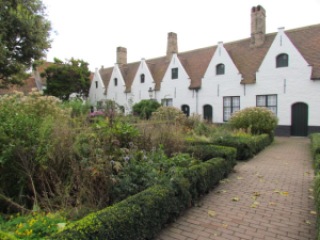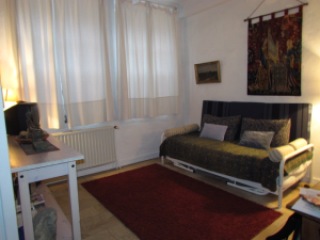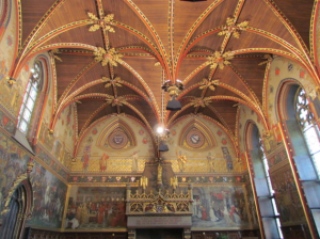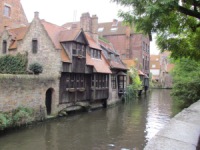Ahhhhh, Bruges…it is one of my favorite, top-ten places in the world! This visit to Bruges made in my fourth time being here. I just adore this quaint, medieval city. I first discovered Bruges, in 1977 traveling with Peter and Ike. We stayed at Snuffles Sleep-In and I remember staying up all night in the lounge drinking wine and listening to good ol’ rock and roll music. Today, Snuffles is still in business. I had hoped to walk by it but unfortunately, never made it.
It was about an eight hour train ride from Munich and since I was leaving at 7:00 in the morning, I got a great deal. For $155, I was able to travel first class. Earlier, when I had inquired about a ticket, the price for just second class was $215! Traveling first class was delightful. Someone to bring me croissants and coffee not to mention more leg room! There was only one little blip in the trip. At one point, we were delayed for about 20 minutes on the route. I had one stop, in Cologne, where I needed to change trains. I had a window of 20 minutes. This delay took care of the time I would have to catch my other train. There were announcements…mostly in German and a few in English but nothing that addressed my current dilemma.
I asked the conductor what I was going to have to do and she said that she would get back to me, which she never did. Fortunately, another lady overheard me asking the questions and she explained to me the announcements that they had been making. She was traveling to Brussels and needed to make the same connections. The announcements said that, instead of getting off at the first Cologne stop, we needed to stay on the train and get off at the second stop. There would be a train waiting for us just across the platform!!! Thank goodness for the kindness of this lady or I would have gotten off at the first stop, like I was originally told to do!
 I arrived, close to 3:00 in Bruges after making a transfer in Brussels. There are trains leaving the Brussels train station frequently for Bruges. It was just so wonderful to be back in Bruges! The old center of the town is within walking distance from the train station. I had made reservations with a lovely couple, Koen & Annemie Dieltiens, (koen.dieltiens@skynet.be) at their Bed and Breakfast. In our email exchange, I mentioned that I was going to be traveling for a month and they offered me a studio apartment for the same price of their B&B….which I gratefully accepted. I much rather stay in a studio than a B&B any day! The apartment was in Huyze de Blokfluit, Peerdenstraat 16, B-8000, Brugge.
I arrived, close to 3:00 in Bruges after making a transfer in Brussels. There are trains leaving the Brussels train station frequently for Bruges. It was just so wonderful to be back in Bruges! The old center of the town is within walking distance from the train station. I had made reservations with a lovely couple, Koen & Annemie Dieltiens, (koen.dieltiens@skynet.be) at their Bed and Breakfast. In our email exchange, I mentioned that I was going to be traveling for a month and they offered me a studio apartment for the same price of their B&B….which I gratefully accepted. I much rather stay in a studio than a B&B any day! The apartment was in Huyze de Blokfluit, Peerdenstraat 16, B-8000, Brugge.
I had this wonderful vision that the apartment was going to be in one of the quaint Flemish style homes that line the streets Bruges and I wasn’t disappointed. The apartment I stayed in was in the white building in this picture and was on the bottom floor. The building was built in the 1500s and the old beam in my apartment was one of the originals! It was perfect and totally met my expectations!
Once I was checked in, I was out the door to explore the city I so loved. It was towards the end of the day and there were a few street vendors selling their art work and other crafts. The tourist were everywhere…it was Sunday, a sunny and clear autumn day…Bruges is a great place to spend such a day!
I bought a waffle from one of the many shops selling them. Bruges and most of Belgium, I believe are known for their tasty waffles, sweet chocolates and french fries. The city was everything I remembered it to be….the lovely canals, cobblestone streets with stone bridges crossing the canals. Large plazas surrounded by inviting restaurants and shops. A great place to order a cup of coffee or glass of wine to people watch.
I ended up on Steenstraat, one of the many pedestrian mall areas for shopping. The weekend I arrived, was a major weekend for sales at the stores. I found a grocery store among the clothing stores a bought a few supplies. As I made my way back to the apartment, I continued to stop to click pictures of everything along the way!
I was in Bruges from Sunday afternoon until the following Friday, October 12. I did some serious sightseeing Monday-Thursday. The tourism department has put together a nice little book with 3 walking tours around Bruges, the history of the city and interviews with famous Bruge people on their favorite places, restaurants, etc in the city. I did all three walking tours and found the information very interesting.
Bruges has been given World Heritage status by UNESCO. In 1134, a storm broke through the Belgium coast and created an inlet to Bruges. This offered access to Bruges from the sea and enabled Bruges to become a major medieval trading port in Europe.
In the 15th century, Bruges experienced a “Golden Age” when the Royal House of Burgundy took up residence in the city. Luxury items were produced, artist like Jan van Eyck and Hans Memling thrived, churches, merchant houses and the town hall were built. This era ended with the death of Mary of Burgundy in 1482. Silt build-up in the Zwin made it difficult for ships to travel to Bruges. the relationship between the citizens and Maximilian of Austria, the lord and widower became strained and he moved to Germany.
In 1892, Georges Rodenbach described Bruges in his book, Bruges la Morte, as a sleepy but mysterious place. Soon, people were flocking to Brugge to discover all the beauty that this city had to offer….and, as they say, the rest is history. Today, tourism and the port of Zeebrugge, 10 miles from Bruges, bring income to the area.
The tourist center also offers a variety of discount cards for tourist to buy to get the best deal for the variety of museums. I opted for the 3 day museum pass. I paid $20.00 and had access to over 15 museums. This turned out to be a great deal as the first two museums that I visited would have cost me $16.00 if I had purchased tickets from them. With my card, I visited nine museums and attractions.
The museums that I visited were the Groeningemuseum, which was their art museum. It had art from 1400s to today. I won’t go into details here about the new artist that I discovered…along with the artist I was familiar with….maybe in another blog. It was a nice museum. Well organized but it was small. After visiting this art museum, right around the corner was the Arent House that had an exhibit by Frank Brangwyn (1867-1956) who was from Bruges. In 1936, he present the city of Bruges with over 400 pieces of his art work. His early works are of a more traditional style with subjects of the sea and life at sea. By the end of the 19th century, Orientalism was popular among many painters. Brangwyn became interested in the bright colors from the countries and made a trip to Istanbul, Turkey and the Black Sea. He made paintings and drawings of Spain, Morocco and Egypt. His travels took him to Africa and South Africa. He even designed stain glass for Tiffany.
He is best known for his work “The British Empire” of which this is a study that he did for it. It is 16 large works that cover over 3,000 ft. and was meant to hang in the Royal Gallery in the House of Lords in Westminster. Once finished, they were deemed to bright and colorful by the House of Lords, who refused to hang them. Today, they are in Brangwyn Hall, Swansea, which is in Wales. Of course, I loved the bright colors he used! They also had a series of drawings that he did on the station of the cross. These were wonderful as well. I really enjoyed learning about this artist.
 Another museum that I visited was the Gruuthuse City Palace. This was the palace of Louise of Gruuthuse who made his fortune from the exclusive rights of the herb mixture “gruut”, which was used to flavor beer before the discovery of hops. Louis was also the commander of the army for Charles the Bold and the personal bodyguard to Mary of Burgundy. He was a cultured man and the family motto was “Plus est en vous”…there is more in you than you think.
Another museum that I visited was the Gruuthuse City Palace. This was the palace of Louise of Gruuthuse who made his fortune from the exclusive rights of the herb mixture “gruut”, which was used to flavor beer before the discovery of hops. Louis was also the commander of the army for Charles the Bold and the personal bodyguard to Mary of Burgundy. He was a cultured man and the family motto was “Plus est en vous”…there is more in you than you think.  Today, the palace is a museum displaying furniture, household objects and art work from the 15th to the 19th century. One of the features that I particularly liked in the palace was the chapel. It is one of the sites I remembered from my visit so many years ago. The chapel is located on the second floor and is connected with the Church of our Lady. The Gruuthuse family didn’t have to leave the palace to attend church on Sunday. This picture shows the chapel with the window that looked down on the church alter and prayer bench. Like my friend, Peter said so many years ago…they could go to church in their pajamas and no one would know the difference!!!
Today, the palace is a museum displaying furniture, household objects and art work from the 15th to the 19th century. One of the features that I particularly liked in the palace was the chapel. It is one of the sites I remembered from my visit so many years ago. The chapel is located on the second floor and is connected with the Church of our Lady. The Gruuthuse family didn’t have to leave the palace to attend church on Sunday. This picture shows the chapel with the window that looked down on the church alter and prayer bench. Like my friend, Peter said so many years ago…they could go to church in their pajamas and no one would know the difference!!! The Church of our Lady is famous for a couple of reasons. It holds the tombs of Mary of Burgundy and Charles the Bold. Plus, a statue of Madonna and Child done by Michelangelo and is the only one of his works to leave Italy in his lifetime. It was purchased by two wealthy Bruges merchants and brought back to their city. It is a beautiful piece of art.
The Church of our Lady is famous for a couple of reasons. It holds the tombs of Mary of Burgundy and Charles the Bold. Plus, a statue of Madonna and Child done by Michelangelo and is the only one of his works to leave Italy in his lifetime. It was purchased by two wealthy Bruges merchants and brought back to their city. It is a beautiful piece of art.  Across the street from the church is the Old Saint John’s Hospital established in the 12th century. It was run by nuns and monks who took care of pilgrims, travelers and the sick. The old pharmacy is well preserved with the original bottles, jars and tins that held the herbs from the herb garden. The hospital was open until 1971 and in 1651, the nuns took over running it. In the church affiliated with the hospital houses six works of art by Hans Memling, who was once a patient at the hospital. It is rumored that he gave four of these pieces to the nuns in gratitude for their care of him.
Across the street from the church is the Old Saint John’s Hospital established in the 12th century. It was run by nuns and monks who took care of pilgrims, travelers and the sick. The old pharmacy is well preserved with the original bottles, jars and tins that held the herbs from the herb garden. The hospital was open until 1971 and in 1651, the nuns took over running it. In the church affiliated with the hospital houses six works of art by Hans Memling, who was once a patient at the hospital. It is rumored that he gave four of these pieces to the nuns in gratitude for their care of him.  This is a picture that shows some of the almshouses that have a beautiful garden in the center of the buildings, which surrounds it.
This is a picture that shows some of the almshouses that have a beautiful garden in the center of the buildings, which surrounds it.
The Bruges’ Folk Museum is in one of these almshouses. I really enjoyed this museum but regretted that the explanations were only in Flemish. Each room in the museum, which was originally a home for one family (they were very, very small!), were dedicated to life in Bruges…a classroom, kitchen, cobbler’s workshop, pharmacy, etc. I particularly enjoyed the kitchen and all the antiques that were displayed.
Lace making used to be very popular in Flanders (the northern part of Belgium) in the 16th century. It is believed that bobin lace making originated in Bruges. Lace making used to be taught in private schools and orphanages during the 16th century. In the 18th century, three nuns developed a school for young women to receive a religious education and get certified in lace making. The lace industry was mostly supported by nobility and the affluent. As time went on, lace was able to be produced in larger quantities by machines. Today, making lace by hand has become more of a leisurely craft. I was able to see a demonstration at the Kantcentrum (Lace museum). In the afternoons, women gather in a room to make lace and people are welcomed to watch. It was pretty amazing. I don’t know how they keep all the bobins in place and work them to create the patterns that they do! There is lace everywhere for sale in Bruges. All of the souvenir shops sell lace items. I just read on “Lonely Planet” website that it is very difficult to find lace that has been made in Bruges in any of these shops. The handmade lace is made and imported from Asia and machine made lace is imported from France. So glad I didn’t buy any as a souvenir from Bruges!!
As I mentioned earlier, there are plazas throughout the city. The most central is known as the Market plaza. Every Wednesday is an open air market in the center of the plaza. There are two very imposing buildings in the square. One is the neo-gothic building of the provincial court and the other is the Belfry tower which has been used for centuries as a lookout for imminent danger to the city. It is about 275 ft high and has 366 steps that tourist can climb today for a view of all of Bruges. It, also, houses a carillon of 47 bells which plays on the quarter of the hour.
The first couple of days I was in Bruges, the carillon didn’t play because BBC was filming a movie in the square. It is going to be called “The White Queen” and I saw some of it being filmed while I was waiting to go up the tower. Also, later in the week, I saw the cast members dressed in their period costumes walking through the streets, as well as horses being taken to the next point of filming. It was fun to see.
Taking a side street from Market Square, I came to Burg (Castle) Square. Here the Old City Hall, the Old Recorders house and the Basilica of the Holy Blood are located.
The Old City Hall is one of the oldest town halls in the area, having been built between 1376 and 1420. It is a beautiful gothic structure and the main attraction is the Great Gothic hall with timber ceiling and wall murals depicting the cities’ history. As you can see, it was a very impressive room.
Finally, in this plaza was the Basilica of the Holy Blood. This is a double chapel. A simple, roman style of arched ceilings. The walls and ceilings all covered in brick and rows of simple wooden pews in the small room. The altar was a large block of stone and behind it, in a small, recessed chamber that held a statue of a golden eagle. It was very comforting to be in such a simple environment. It had a very pious feeling to it.
Upstairs is another chapel that is much more elaborate and is done in the Gothic style….high arched ceiling that are painted, walls with murals and gilded bronze statues. This is where the Relic of the Holy Blood can be viewed. This relic was brought back to Bruges by Thierry of Alsace from his crusade in 1147 to the region now known as Jerusalem. Thierry returned to Bruges on April 7, 1150 with a vial of what is said to contain the blood of Jesus.
I actually got to see it. Not being raised Catholic, I don’t have an appreciation for the variety of relics one can see in the Catholic churches while traveling through Europe. Every church has at least one or more ornate gold or silver relic holder, with a clear glass container, to house the bone, tooth, hair or some other small body part of one of their many saints. Honestly, I have found it a tad unsettling to be viewing something like this. Seeing what was supposedly the Blood of Christ was no different for me. I didn’t have some overwhelming spiritual awakening while viewing it. Although, I must say, I believe many people were quite moved seeing it.
From what I have researched, the Bible does not refer to anything about Christ’s blood being saved. However, in the apocryphal gospel…used by the Catholics, there is reference that Joseph of Arimathea preserved the Precious Blood after he washed the body of Christ. Each year, on the day of Ascension, there is a Procession of the Holy Blood through Bruges. This has been practiced since the 13th century as thanks for the release from French rule. Today, the residence create a historical reenactment of the arrival of the vial to the city. It must be quite a sight to see…the costumes, the horses parading through this medieval city!
That is some of the highlights of the museums and historical buildings that you can see in Bruges. My memories will be more of the beautiful canals that are lit at night and reflect the Flemish style buildings in the dark water. There is one particular canal behind the Church of our Lady which I found most charming. It had a small stone bridge of brownish hue that led you from the churchyard to a park. The wooded fronted buildings that hugged the canal nearby. Oh, did I mention in the churchyard, there were crosses from other church steeples in Bruges. These crosses were removed during World War II so the Germans couldn’t identify buildings from the air. For whatever reason, they were never put back.
I’ll remember the wonderful meal of mussels, french fries and wine that I had one quiet Sunday night and while walking home, discovering the Est Wine Bar. There was wonderful blues music coming from the second floor of the building. I walked into this small, and I mean small, building that was so crowded, I could stand just inside the door. I ordered a wine and rocked to the music with a young man from England and a couple from the Netherlands. The musician was great and had the place hopping.
Then, there was the beautiful yellow lab who slept everyday in the open window overlooking the canal. I saw him as I walked by. Such a beautiful boy and I think, he had the best spot in town.
How can I forget the delightful afternoon coffee I had at the Tea Room de Proeverie near St John’s Hospital/Chapel. I ordered a coffee and scone and they were served in such an artist way. The scone was on a plate that held a small bowl of whipped cream and another small bowl of strawberry jam. The coffe was served on a small tray complete with a small creamer of milk and a small dish of delightful chocolate!
Oh and speaking of chocolate…the Dumon Chocolate shop. It was recommended by Rick Steves and it was a very good recommendation! It is some of the best chocolate I have ever had. Dumons is one of the few chocolate shops that still make their own chocolate! After I made my purchase, the lady gave me a chocolate covered caramel…my favorite!!! I just let it melt in my mouth and made it last for as long as I could.
I can’t end this entry without writing about the adorable busker (street musician) who was playing a guitar that was bigger than he was. Kudos to him for trying it. He was making a pretty good haul. Maybe he only knew one song but he was so cute and only about 11 years old…he was so cute that you couldn’t help but tip him!
Yes, I love, love, love Bruges. David and I even discussed the possibility of living there. As much as I love it, I don’t know if I could live there. Once you have visited all the tourist attractions, there isn’t much for one to do.
So, there you have it…my month of wonderful travel adventures. Stay tuned as there will be more adventures from London………….











